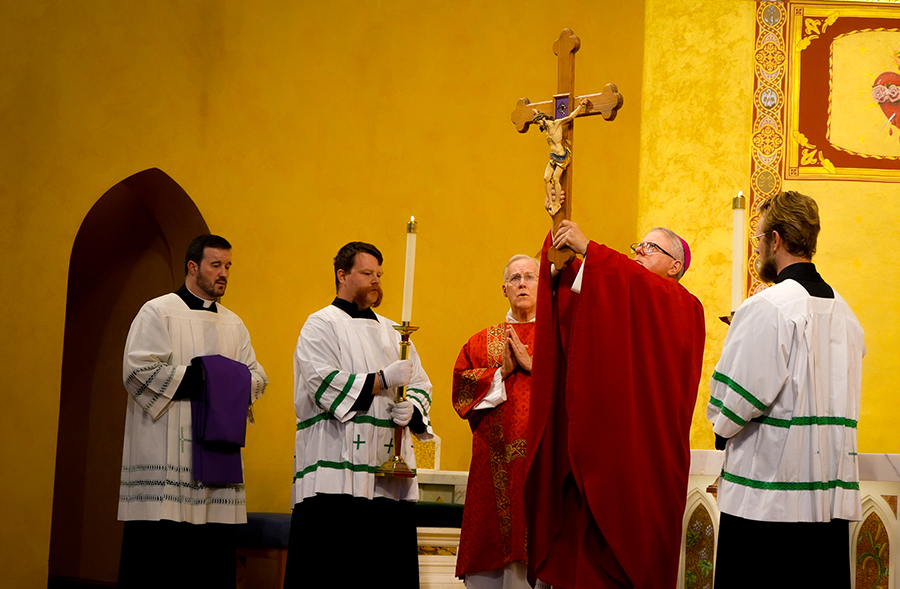
Bishop Martin urges people to take up their crosses on Good Friday
CHARLOTTE — More than 200 worshipers watched on Good Friday as Bishop Michael Martin and other clergy prostrated themselves on the wooden floor of St. Patrick Cathedral in an act of humility. The bishop asked them: “What will be your response” to the crucifixion of Christ?
“I felt overwhelmed in a good way,” said St. Gabriel parishioner Loren Barrett. “I cried since the moment the priests walked in and laid on the floor. I thought, ‘What have we done?’ I wasn’t expecting it to be this emotional.”
The somber liturgy for Good Friday, starting at 3 p.m. – traditionally noted as the time of Jesus' death – began with the Old Testament prophecy of the suffering servant in Isaiah 52, then Jesus, the great high priest who can sympathize with man in Hebrews 4, and ended with John’s account of the Lord’s Passion.
Bishop Martin’s Good Friday message urged people to do two things as they contemplate the Crucifixion: realize the serious role played by acknowledging fault, and recognize the gift they can give to the world through their own small crucifixions.
On this day, he said, “We should feel uncomfortable – that is the nature of the Crucifixion.”
“The crucifix requires a response,” he said. “In fact, it demands a response. We cannot simply sit, kneel or stand before it. It is far more compelling. What will be your response?”
As he explained, “The crucifix compels the truth. The truth is my, your fall; we did that. That’s our fault. The fact that the innocent Son of God would take onto Himself the blame, burden and suffering should cause us to want to do that, too.”
He ended by urging people to go out into the world and be crucified by dying to themselves.
‘The crucifix requires a response. In fact, it demands a response. We cannot simply sit, kneel or stand before it. It is far more compelling. What will be your response?’— Bishop Michael Martin, OFM Conv.
Deacon Brian McNulty chanted the traditional 10 Solemn Intercessions of the Good Friday liturgy as the congregation knelt, united with millions around the world in prayer for the Church, the pope, the bishop and the clergy, people preparing for baptism, the unity of Christians, for the Jewish people, those serving in public office, and those who don’t know or do not acknowledge God.
Bishop Martin, the altar servers and clergy departed, then returned moments later with a purple cloth-wrapped crucifix. In the back recesses of the church while singing “Behold the wood of the Cross, on which hung the salvation of the world,” the bishop unveiled the crucifix.
With the same lips used to kiss people’s feet at the Mass of the Lord’s Supper the night before, the bishop venerated the cross, bowing down and kissing the feet of Christ. Then a long line formed as women, men and children reverenced the cross with silent kisses, touches and genuflections – some with tears as they knelt – while the choir sung the hymn “Crucem Tuam” and then chanted the “Reproaches,” composed by Renaissance musician Tomás Luis de Victoria, ending with a veneration hymn called “Crux Fidelis” (“Faithful Cross”).
The cathedral’s crucifix used for veneration on Good Friday features an encased relic of wood from Jesus’ true cross, and some felt a special blessing with their reverent kiss.
“There was something there, that I never felt before in front of the crucifix,” said an emotional Barrett. “I felt so much mercy, too, that we were even able to get to be there in His Presence. I really felt like one of His disciples who betrayed Him. I thought, ‘We blew it.’ And we continue to blow it every day, but He lets us try again. I felt I didn’t deserve to be here, only by His mercy.”
Following veneration, consecrated Hosts from the prior evening’s Mass enabled the congregation to receive Communion on the only day of the year when Mass is not celebrated.
The clergy in their red vestments and the altar servers in their red cassocks then left the cathedral in silence, leaving the congregation to ponder their response to the wooden crucifix, surrounded by lit candles on the altar.
— Lisa M. Geraci

















































